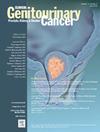德国北莱茵-威斯特伐利亚州前列腺癌患者的发病率和生存率
IF 2.3
3区 医学
Q3 ONCOLOGY
引用次数: 0
摘要
在德国没有有组织的前列腺癌筛查。本研究的目的是调查原发性前列腺恶性肿瘤患者发病率和生存率的发展与指南中前列腺特异性抗原(PSA)筛查建议的变化之间的关系。方法:使用北莱茵-威斯特伐利亚州癌症登记处1992-2019年m本文章由计算机程序翻译,如有差异,请以英文原文为准。
Incidence and Survival of Patients With Prostate Cancer in North-Rhine Westphalia, Germany
Introduction
There is no organized prostate cancer screening in Germany. The aim of this study was to investigate the development of incidence and survival in patients with primary malignant tumors of the prostate in relation to changing recommendations of prostate-specific antigen (PSA) screening in guidelines.
Methods
Age-standardized incidence rates and 5-year relative survival (RS) (period approach) were calculated using data from the cancer registry North Rhine-Westphalia with the subset of the administrative district Münster respectively for the years 1992-2019. Analyses were stratified according to TNM classification.
Results
Until 2008 overall prostate cancer incidence increased, followed by a decrease up to 2017 and another increase thereafter. The same trend was observed in nonmetastatic but not in metastatic prostate cancer. Overall 5-year RS showed an increase of 10 percentage points up to period 2005-2009, followed by a constant RS. 5-year RS of patients with distant metastases remained constant from period 2000-2004 to 2015-2019, while 5-year RS with nonmetastatic prostate cancer and lymph node metastases increased slightly.
Discussion
Overall and nonmetastatic incidence rates reflect changes of recommendation in PSA screening guidelines from the United States. Accordingly, the increase in 5-year RS might be influenced by lead time bias. Incidence and survival of metastatic prostate cancer barely suggest any association with changing PSA screening recommendations.
Conclusion
Structured early detection of metastases with additionally applied diagnostic methods might improve 5-year RS rates of metastatic prostate cancer patients.
求助全文
通过发布文献求助,成功后即可免费获取论文全文。
去求助
来源期刊

Clinical genitourinary cancer
医学-泌尿学与肾脏学
CiteScore
5.20
自引率
6.20%
发文量
201
审稿时长
54 days
期刊介绍:
Clinical Genitourinary Cancer is a peer-reviewed journal that publishes original articles describing various aspects of clinical and translational research in genitourinary cancers. Clinical Genitourinary Cancer is devoted to articles on detection, diagnosis, prevention, and treatment of genitourinary cancers. The main emphasis is on recent scientific developments in all areas related to genitourinary malignancies. Specific areas of interest include clinical research and mechanistic approaches; drug sensitivity and resistance; gene and antisense therapy; pathology, markers, and prognostic indicators; chemoprevention strategies; multimodality therapy; and integration of various approaches.
 求助内容:
求助内容: 应助结果提醒方式:
应助结果提醒方式:


